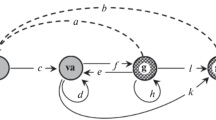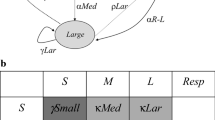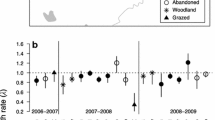Abstract
Furcraea parmentieri (Roezl ex Ortgies) García-Mend. is a long-lived, semelparous threatened species with a restricted geographic distribution. We studied the demography of this species in southwest of Mexico City using periodic matrices. We followed the fate of 404 individuals (in 2006–2007) and performed seed germination and seedling establishment experiments in the field (in 2007–2008) to estimate survival, growth and reproduction probabilities of individuals in eight size categories, according to plant height. Population structure was characterized by a high number of saplings, as well as medium and large plants. We built three annual matrices that described the demography in different phases of the population cycle: regular years (RG) characterized by low fecundity and low adult mortality; mast-seeding years (MS) with low seedling emergence and high adult mortality (related to semelparity); and post mast-seeding years (PS) with a high emergence of seedlings and bulbils. Periodic matrices were built simulating three scenarios, which consisted of mast-seeding events occurring every 5, 10, or 15 years. Finite population growth rates (λ) were 1.03 (RG year), 0.99 (MS year), and 1.25 (PS year). The long term population growth rate values projected over a 90 year period (estimated on an annual basis) were higher as the frequency of mast-seeding events increased. We estimated that individuals reproduce at an age of 60–90 years and that most new recruits originate via sexual reproduction. Although the population has a potential for growth, its persistence may be threatened due to land use change.



Similar content being viewed by others
References
Albarrán M (2011) Biología reproductiva de Furcraea parmentieri (Agavaceae). B. Sc. Thesis, Universidad Nacional Autónoma de México. México D.F. (in Spanish with English abstract)
Antonovics J, McKane AJ, Newman TJ (2006) Spatiotemporal dynamics in marginal populations. Am Nat 167:16–27
Arizaga-Pérez JS (1998) Biología reproductiva de Agave macroacantha Zucc. en Tehuacán, Puebla. Ph.D. Thesis, Universidad Nacional Autónoma de México. México D.F. (in Spanish)
Bárceinas A (2011) Genética de poblaciones de Furcraea parmentieri (Agavaceae): Estimaciones de variación y estructura genética usando ISSR’s. B. Sc. Thesis, Universidad Nacional Autónoma de México. México D.F. (in Spanish with English abstract)
Beissinger SR (1995) Modeling extinction in periodic environments: Everglades water levels and Snail Kite population viability. Ecol Appl 5:618–631
Bierzychudek P (1982) The demography of jack-in-the-pulpit, a forest perennial that changes sex. Ecol Monogr 52:335–351
Carrillo C (1995) El Pedregal de San Ángel. Universidad Nacional Autónoma de México, México D.F. (in Spanish)
Caswell H, Trevisan M (1994) Sensitivity analyses of periodic matrix models. Ecology 75:1299–1303
Crone EE, Ellis M, Menges E, Bell T, Bierzychudek P, Ehrlén J, Kaye T, Knight T, Lesica P, Morris W, Oostermeijer G, Quintana-Ascencio P, Ticktin T, Valverde T, Williams J (2011) How do plant ecologists use matrix population models? Ecol Lett 14:1–8
Crone EE, Ellis MM, Morris WF, Stanley A, Bell T, Bierzychudek P, Ehrlén J, Kaye TN, Knight TM, Lesica P, Oostermeijer G, Quintana-Ascencio PF, Ticktin T, Valverde T, Williams JL, Doak DF, Ganesan R, McEachern K, Thorpe AS, Menges ES (2013) Ability of matrix models to explain the past and predict the future of plant populations. Conserv Biol 27:968–978
Davis AS, Dixon PM, Liebman M (2004) Using matrix models to determine cropping system effects on annual weed demography. Ecol Appl 14:655–668
Eguiarte LE, Souza V, Silva-Montellano A (2000) Evolución de la familia Agavaceae: filogenia, biología reproductiva y genética de poblaciones. Boletín de la Sociedad Botánica de México 66:131–150 (in Spanish with English abstract)
Emery SM, Flory SL, Clay K, Robb JR, Winters B (2013) Demographic responses of the invasive annual grass Microstegium vimineum to prescribed fires and herbicide. For Ecol Manage 308:207–213
Enright N, Ogden J (1979) Applications of transition matrix models in forest dynamics: Araucaria in Papua New Guinea and Nothofagus in New Zealand. Austral Ecol 4:3–23
García E (2004) Modificaciones al sistema de clasificación climática de Köppen, 5th edn. Instituto de Geografía, Universidad Nacional Autónoma de México, México D.F. (in Spanish)
García-Mendoza AJ (2000) Revisión taxonómica de las especies arborescentes de Furcraea (Agavaceae) en México y Guatemala. Boletín de la Sociedad Botánica de México 66:113–129 (in Spanish with English abstract)
Golubov J, Mandujano MC, Franco M, Montaña C, Eguiarte LE, López-Portillo J (1999) Demography of the invasive woody perennial Prosopis glandulosa (honey mesquite). J Ecol 87:955–962
Gutterman Y (2000) Maternal effects on seeds during development. In: Fenner M (ed) Seeds: The ecology of regeneration in plant communities, 2nd edn. CAB International, Oxford, pp 59–83
Hernández-Pedrero RG (2009) Estudio poblacional de Furcraea parmentieri (Agavaceae) en bosques templados del suroeste del Distrito Federal, México. B. Sc. Thesis, Universidad Nacional Autónoma de México. México D.F. (in Spanish with English abstract)
Horvitz CC, Schemske DW (1995) Spatiotemporal variation in demographic transitions of a tropical understory herb: projection matrix analysis. Ecol Monogr 65:155–192
Ives AR, Jansen VAA (1998) Complex dynamics in stochastic tritrophic models. Ecology 79:1039–1052
Janzen D (1976) Why bamboos wait so long to flower. Ann Rev Ecol Syst 7:347–391
Jenouvrier S, Caswell H, Barbraud C, Weimerskirch H (2010) Mating behaviour, population growth, and the operational sex ratio: A periodic two-sex model approach. Am Nat 175:739–752
Jongejans E, de Kroon H (2005) Space versus time variation in the population dynamics of three co-occurring perennial herbs. J Ecol 93:681–692
Kaye TN, Pyke DA (2003) The effect of stochastic technique on estimates of population viability from transition matrix models. Ecology 84:1464–1476
Keely JE, Bond WJ (1999) Mast flowering and semelparity in bamboos: the bamboo fire cycle hypothesis. Am Nat 154:383–391
Lesica P, Shelly JS (1995) Effects of reproductive mode on demography and life history in Arabis fecunda (Brassicaceae). Am J Bot 82:752–762
Mandujano MC, Montaña C, Franco M, Golubov J, Flores-Martínez A (2001) Integration of demographic annual variability in a clonal desert cactus. Ecology 82:344–359
Mertens SK, van den Bosch F, Heesterbeek JAP (H) (2002) Weed population and crop rotations: exploring dynamics of a structured periodic system. Ecol Appl 12:1125–1141
Mertens SK, Yearsley JM, van den Bosch F, Gilligan CA (2006) Transient population dynamics in periodic matrix models: methodology and effects of cycle permutations. Ecology 87:2338–2348
Mondragón D, Durán R, Ramírez I, Valverde T (2004) Temporal variation in the demography of the clonal epiphyte Tillandsia brachycaulos (Bromeliaceae) in the Yucatan Peninsula, Mexico. J Trop Ecol 20:189–200
Nakaoka M (1997) Demography of the marine bivalve Yoldia notabilis in fluctuating environments: an analysis using a sthochastic matrix model. Oikos 79:59–68
Noreen EW, Griffith B, McCabe TR (1995) Evaluating growth of the Porcupine caribou herd using a stochastic model. J Wildl Manage 59:262–272
Olmsted I, Alvarez-Buylla ER (1995) Sustainable harvesting of tropical trees: demography and matrix models of two palm species in Mexico. Ecol Appl 5:484–500
Picó FX, de Kroon H, Retana J (2002) An extended flowering and fruiting season has few demographic effects in a Mediterranean perennial herb. Ecology 83:1991–2004
Piñero D, Martínez-Ramos M, Sarukhán J (1984) A population modelo of Astrocaryum mexicanum and a sensitivity analysis of its finite rate of increase. J Ecol 72:977–991
Rees M, Ellner SP (2009) Integral projection models for populations in temporally varying environments. Ecol Monogr 79:575–594
Rundel P, Witter M (1994) Population dynamics and flowering in a Hawaiian alpine rosette plant, Argyroxiphium sandwicense. In: Rundel P, Smith A, Meinzer F (eds) Tropical alpine environments: Plant form and function. Cambridge University Press, Cambridge, pp 296–306
Rzedowski GC, Rzedowski J (2005) Flora fanerogámica del Valle de México, 2nd edn. Instituto de Ecología, A.C. and Comisión Nacional para el Conocimiento y Uso de la Biodiversidad, Pátzcuaro (Michoacán), México (in Spanish)
Salguero-Gómez R, de Kroon H (2010) Matrix projection models meet variation in the real world. J Ecol 98:250–254
SEMARNAT (2010) Norma Oficial Mexicana NOM-059-SEMARNAT-2010, Protección ambiental - Especies nativas de México de flora y fauna silvestres - Categorías de riesgo y especificaciones para su inclusión, exclusión o cambio - Lista de especies en riesgo. Diario Oficial de la Federación (Segunda Sección), 30 de diciembre de 2010, México (in Spanish)
Shyu E, Pardini EA, Knight TM, Caswell H (2013) A seasonal, density-dependent model for the management of an invasive weed. Ecol Appl 23:1893–1905
Silvertown J, Franco M, Pisanty I, Mendoza A (1993) Comparative plant demography – relative importance of life-cycle components to the finite rate of increase in woody and herbaceous perennials. J Ecol 81:465–576
Smith A, Young T (1994) Population biology of Senecio keniodendron (Asteraceae) - an Afroalpine giant rosette plant. In: Rundel P, Smith A, Meinzer F (eds) Tropical alpine environments: Plant form and function. Cambridge University Press, Cambridge, pp 276–293
Smith A, Caswell H, Mettler-Cherry P (2005) Stochastic flood and precipitation regimes and the population dynamics of a threatened floodplain plant. Ecol Appl 15:1036–1052
Stevens JT, Latimer AM (2015) Snowpack, fire, and forest disturbance: interactions affect montane invasions by non-native shrubs. Global Change Biol 21:2379–2393
Vavrek M, MacGraw J, Yang S (1997) Within-population variation in demography of Taraxacum officinale: season- and size-dependent survival, growth and reproduction. J Ecol 85:277–287
Young T (1994) Population biology of Mount Kenya lobelias. In: Rundel P, Smith A, Meinzer F (eds) Tropical alpine environments: Plant form and function. Cambridge University Press, Cambridge, pp 251–272
Acknowledgements
We thank Dr. L.E. Eguiarte, Dr. M.C. Mandujano, Dr. S. Arizaga and Dr. A. García-Mendoza for valuable comments and suggestions to a previous version of this manuscript. We are grateful to Dr. M. Hernández-Aploinar, Dr. P.E. Mendoza-Hernandez and M.Sc. A. Mena for help and advice during field work. We also thank Dr. C. Martorell for valuable assistance with the analysis of periodic matrices.
Author information
Authors and Affiliations
Corresponding author
Rights and permissions
About this article
Cite this article
Hernández-Pedrero, R., Valverde, T. The use of periodic matrices to model the population dynamics of the long-lived semelparous Furcraea parmentieri (Asparagaceae) in a temperate forest in central Mexico. Popul Ecol 59, 3–16 (2017). https://doi.org/10.1007/s10144-017-0572-7
Received:
Accepted:
Published:
Issue Date:
DOI: https://doi.org/10.1007/s10144-017-0572-7




